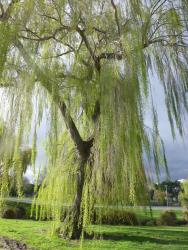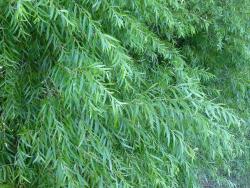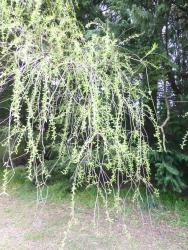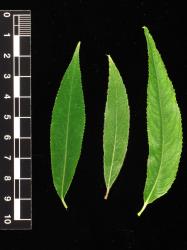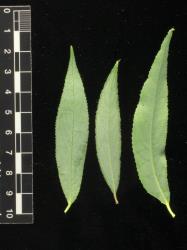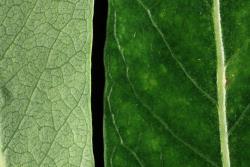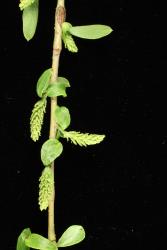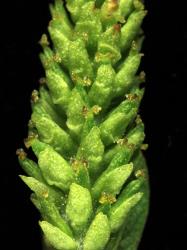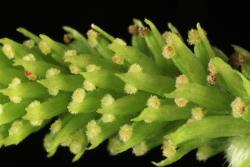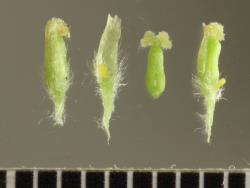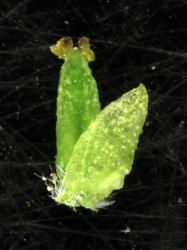- = Salix ×blanda Andersson, Kungl. Svenska Vetenskapsakad. Handl. 6: 50 (1867)
Branchlets weeping, unbranched terminal portion up to 1.5 m long. Current year's branchlets moderately densely short-silky hairy, green or strong yellow-green. Year-old branchlets light olive (UCL106), glabrous, 1.4–2.1 mm diameter. Flower bud scales 4.6–5.0 mm long, 2.2 mm wide, 1.5 mm deep, ovoid with 2 angles, dark orange-yellow to dark yellowish brown (UCL72–78), glabrous or densely short-silky hairy. Stipule persistent, 6–13 mm long, very narrowly asymmetrically ovate; always toothed, apex acuminate. Emerging leaves green. Leaf lamina 105–173 mm long, 15–35 mm wide, falcate or straight; upper leaf surface with stomata varying between dense over the whole surface to absent, often dense only near the midvein. Catkins female. Flowering branch 25–40 mm long, with 2–5 leaves. Flower bract 2.0–6.0 mm long, 0.5–1.0 mm wide, female bract usually persisting, rarely deciduous and then very late after flowering. Female nectary 0.4–0.8 mm long, 0.5–0.7 mm wide.
A very common cultivated weeping willow on both river and stream banks, and on well-drained soils. A tree with greyish yellow-green, pendulous, year-old branchlets. Leaves are sometimes noticeably mottled green and yellow-green. Leaves in late summer are brittle, leading to broken tips and more extensive damage at times. Leaves on the hanging branchlets tend to form a herringbone pattern; i.e., the leaves form regular alternating diagonals in a way that is not seen in other tree willows here. Stomata on the upper surface are moderately dense near the midvein but sparse elsewhere. Young leaves are glaucous on the underside, but this waxy coating rubs off mature leaves, although the leaves still look grey due to dense stomata there. Meikle (1984) describes the leaves as "persistently glaucous below", but in New Zealand by late summer mature leaves have lost their glaucousness. Catkins in New Zealand and overseas are always female. The flower bract often develops a brown spot at the apex (visible only in fresh material). The stipule is persistent and obvious on branches in late summer.
Most similar to Salix ×pendulina f. salamonii, golden weeping willow. The two forms are the only weeping willows in New Zealand, although other tree willows have hanging branchlets to a lesser degree. Both forms have long, hanging branchlets that reach the ground or water level and are unbranched for a metre or more. Where they hang over flowing water the long branchlets become entwined into 'ropes'. Mature leaves of f. pendulina are brittle and become damaged by wind where they are on long, hanging branchlets; this is not a feature of f. salamonii. Forma pendulina is always female in New Zealand and catkins are never mixed in their sexuality, as in f. salamonii. Forma pendulina has 1-year-old branchlets that are a greenish grey with a grey or yellow-grey, thin, glossy surface over a green under-surface, while f. salamonii branchlets are a uniform golden colour. New spring branchlets of f. pendulina are strong yellow-green, while f. salamonii branchlets are brilliant yellow-green. Forma pendulina is variable in the density of stomata on the upper leaf surface, while in f. salamonii the stomata are uniformly dense.
Salix ×pendulina f. pendulina trees without long-pendent branches can be difficult to distinguish from female plants of S. ×fragilis f. fragilis. Plants with abundant leaf galls and uniformly dense stomata on the upper surfaces will be S. ×fragilis f. fragilis.
Taranaki (Kawhātau River 1995), Canterbury (Christchurch 1964), Chatham Island (2006).
Only two definite records of naturalisation exist.
First collection: CHR 232223, A. J. Healy 64/284 & B. Parham, 12 October 1964, Christchurch, Heathcote River, near Opawa Road bridge. The collectors did not state that the plant was wild and the site is one where planted trees could be expected. Alternatively, a specimen, CHR 505994, C. C. Ogle, 1995, Kawhātau R., is the first wild collection.
First publication: Kirk (1882, p. 292) listed Salix babylonica, weeping willow, as naturalised in profusion on the banks of the Wairoa River and the Waikato River. Without a voucher it is difficult to know if this refers to S. ×pendulina or S. babylonica.
Flowering: Late August–mid-October.
Tetraploid (2n = 76 CCDB based on 2 counts).
This hybrid was referred to in Webb et al. (1988) as Salix ×sepulcralis Simonk. which Simonkai (1890) published as Salix alba × S. babylonica. Belyaeva (in Belyaeva et al. 2018) believes the weeping willow hybrid is Salix alba × S. babylonica × S. euxina. For this reason, Salix ×sepulcralis Simonk. is not listed as a synonym.



